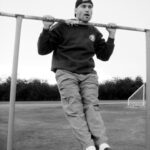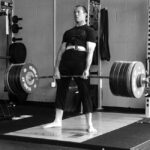Want to increase your pullup reps? How about improve your pullup technique? We have a program that delivers and, provided you follow its principles, is virtually foolproof. But it isn’t for the faint-hearted. Having a solid understanding of those principles will help, as will lessons learned in the field by top TSC competitor, Alex Tanskey.
I resisted the Fighter Pullup Plan for years, convinced that I was different. My body didn’t need—or to be honest, couldn’t handle—the program’s volume. Sure, it had worked for friends of mine. But I knew I would be an exception. And then I tried it.
I was wrong—about everything.
The Fighter Pullup Plan is well known in the StrongFirst community for a good reason: it works. In only six weeks, I increased my bodyweight pullups from 16 to 24. I experienced a more substantial increase using this program than I did in the previous three years training pullups two to three times per week.
The Fighter Pullup Plan worked so well that it helped me finish first overall in the Fall 2018 Tactical Strength Challenge (Men’s Open). Even though I had stopped training the program four months before the TSC, I continued to use its principles to a new high of 25 during the competition, beating my previous best. These ‘magical’ pullup principles are repeated exposure, greasing the groove, and always leaving something in the tank.
But before you embark on your fighter pullup journey, you may appreciate a reality check: the volume is REAL. Over 22 training sessions—I cut the plan short by a few days due to travel and logistics—I performed 1,681 pullups. That’s an average of 76 pullups each session. People must have thought I did pullups for a living by the time I finished.
Not scared off yet? Good. Whether you are looking to complete your first set of 5, or 25, this plan will improve both the quantity and quality of your pullups. Now, let me explain each principle and the lessons I learned along the way.
1. Greasing the Groove is Real
As Craig Marker explains here, “greasing the groove” means practicing the same exercise frequently, without ever going to failure. It’s a popular StrongFirst principle because 1) it works and 2) it treats exercises as skills, rather than something you do for a “workout.” I used this method years ago with front squats to dial in my technique and improve an exercise I had always dreaded.
By staying away from failure, slowly nudging the intensity, and systematically increasing my weekly volume of pullups, my numbers began to climb. A week into the program, I no longer had the anticipatory dread of the first (and longest) set, because I wasn’t preoccupied with the thought of missing a rep. Soon I was hitting more reps on my subsequent sets than I did on my first day, with the feeling that I had more in the tank. Hindsight is 20/20. I wish I would’ve used this method on my pullups sooner.
While training for the TSC last year, I thought I was following The Plan’s principles. But I wasn’t. Specifically, I’d perform three all-out sets of pullups three times per week, going to failure each time. It felt like I was improving and I was hitting new highs for a few weeks. But then reality hit.
About a month before the TSC, my performance waned. I was struggling to reach numbers I had easily hit a month earlier. To cap it off, I hit 17 pullups during the TSC for the second year in a row despite the time and effort I put into preparation. I had trained harder, not smarter.
My experience with the Fighter Pullup Plan couldn’t have been more different. I never missed a rep during the program and was blown away with how much I improved in only 22 sessions. After all, “if you train to failure, you’re training yourself to fail.”
2. Increase Your Efficiency
Through the first few weeks on the program, I sensed that I had to make my reps feel easier if I wanted continual improvement. Then I had a double breakthrough: I needed better control of my body and I needed to use lower threshold strategies to help my endurance.
For example, I would always attempt to pull myself as high as possible, while crushing my abs in the hollow position on the first rep. These are great strategies for near max strength pullups—like pullups with the Beast, or attaining your first pullup—but not a great strategy to save energy for higher reps. Also, as I fatigued, my body would swing between each rep, so I was wasting energy to steady myself before the next pullup.
To break these habits, I started using only as much energy as necessary and put a bench in front of me to stop my swinging. Since I could now only go straight up and down, I was re-grooving a more efficient pullup pattern. I felt an immediate difference and started saving the higher threshold strategies for when I needed to grind out a few reps at the very end.
3. It’s a Game of Fatigue Management
The final lesson I learned was that when it comes to increasing your number of pullups, it really is a matter of managing fatigue—mental and physical. When you’re hanging there hoping to eke out a few more reps, it can be hard to tell the difference between the two.
While there is no absolute “best way” to prepare yourself for high rep pullups, I’ve found the best strategy for me is to break large numbers into stages. Stage one is completing as many as I can in an unbroken set. I’ve found that speeding up the time between pullups—but still performing them to technical proficiency—significantly increased my total. For example, the total amount of time I spent on the bar while doing 17 pullups last year (75 seconds) wasn’t all that much shorter than my set of 24 pullups (90 seconds). I believe this illustrates how energy systems still play a role when it comes to my grip strength. Being more efficient with my time helped me accomplish more, even if I start to run out of ATP at the 90-second mark.
Stage two is allowing myself to take one hand off the bar to practice the principle of “fast and loose” while still hanging with my other hand. Once I got over the initial fear of not being able to get my hand back on the bar, it felt like I had refreshed my grip and increased my “reps in the tank” by three to five pullups. Even a short break of five to ten seconds has an impact as it allows me to regroup mentally for the last few grinds.
The last stage is allowing myself to rest and regroup at the bottom, in between my last few pullups. Of course, I’m not going to have a conversation while hanging there but I’ve tried to find that “sweet spot” where I’m getting just enough air and rest, without letting my grip fatigue at the bottom.
So the take-home lesson is that the Fighter Pullup Plan is not for the faint of heart, as it tests your commitment, mettle, and strength. But for those brave enough to try it, you won’t walk away disappointed as long as you follow its principles (and maybe my lessons too).






Good article Alex!
After reading this article back in December 2018, i have completed three cycles of the “Fighter Pull-ups”. I will share my reps and time at the end. I tested before i started at 16 reps. My first cycle was very easy to get my body prepared for what was to come, It paid off, no sore elbows!! After the second cycle, I tested at 24 and third cycle 30.
There was a few occasions that i would take an extra off day if my body was asking for it. During this time I also pulled a dead-lift PR of 417 (body weight 160). I believe this was possible due to an increase in grip strength and better core loading.
1st cycle started with 12, 10, 8, 6, 4 and 3 minutes per
2nd cycle started with 14,12,10,8,6 and 3 minutes per, however after the second rest day I increased my time to 5 minutes per
3rd cycle started with 16,14,12,10,8 and 5 minutes per
4th cycle in progress
Alex,
Great stuff, it seems so easy until you realize that it’s not easy to do the work required.
It’s funny, because I’ve noticed the exact same effect, when applying the same strategy, to increase my max reps for Pushups.
Stay Strong
Elbow pain from pull ups is likely “golfer’s elbow” a. k. a. medial epicondylitis. Solution is a brace for “tennis elbow” but placed over the medial forearm instead.
@Wily and @Jared, we encourage anyone with pain to seek advice from a medical professional and to follow that advice.
I would appreciate it if one of the Strong First experts would write an article about how to set up a full body exercise program with the Fighter Pull Up Plan at it’s core.
Thanks
Thanks for your experience! I liked the program’s approach a lot, but I guess my technique was not spot-on, and alas, my elbows paid for many months afterwards after I finally stopped about 7 weeks in.
I’d be curious to see if anyone has strategies for preventing something like this from happening. I’ve had elbow pain related to pull ups before. I’m wondering if doing some sort of finger extensor training would help counteract this from happening.
Good article for all the non-believers…
It does work!
Interesting article Alex. I enjoyed reading it 🙂
Thank you, Sasa! Hope it’s helpful.